Capetian Dynasty Definition Ap World History
For the "Direct Capetians", who ruled France from 987 to 1328, see House of Capet.
| Capetian dynasty | |||
|---|---|---|---|
 Capetian Armorial | |||
| Country | France | ||
| Parent house | Robertians | ||
| Titles | *Latin Emperor of Constantinople,
| ||
| Founder | Hugh Capet | ||
| Current head | Louis Alphonse, Duke of Anjou | ||
| Founding year | 987 | ||
| Ethnicity | Frankish | ||
| Cadet branches | See below | ||
The Capetian dynasty / k ə ˈ p iː ʃ ⁱ ən / , also known as the House of France, is a dynasty of Frankish origin, founded by Hugh Capet. It is among the largest and oldest European royal houses, consisting of Hugh Capet's male-line descendants. It ruled in France as the House of Capet from the ascension of Hugh Capet in 987 until the death of Charles IV in 1328.
The dynasty had a crucial role in the formation of the French state. Initially obeyed only in their own demesne, the Île-de-France, the Capetian kings slowly, but steadily, increased their power and influence until it grew to cover the entirety of their realm. For a detailed narration on the growth of French royal power, see Crown lands of France .
Members of the dynasty were traditionally Catholic. The early Capetians had an alliance with the Church. The French were also the most active participants in the Crusades, culminating in a series of five Crusader Kings - Louis VII, Philip Augustus, Louis VIII, Saint Louis, and Philip III. The Capetian alliance with the papacy suffered a severe blow after the disaster of the Aragonese Crusade. Philip III's son and successor, Philip IV, humiliated a pope and brought the papacy under French control. The later Valois, starting with Francis I, ignored religious differences and allied with the Ottoman Sultan to counter the growing power of the Holy Roman Empire. Henry IV was a Protestant at the time of his accession, but realized the necessity of conversion after four years of religious warfare.
The Capetians generally enjoyed a harmonious family relationship. By tradition, younger sons and brothers of the King of France are given appanages for them to maintain their rank and to dissuade them from claiming the French crown itself. When Capetian cadets did aspire for kingship, their ambitions were directed not at the French throne, but at foreign thrones. Through this, the Capetians spread widely over Europe.
In modern times, both King Felipe VI of Spain and Grand Duke Henri of Luxembourg are members of this family, both through the Bourbon branch of the dynasty. Along with the House of Habsburg, it is one of the two most powerful continental European royal families, dominating European politics for nearly five centuries.
Contents
- 1 Name origins and usage
- 2 The Robertians and before
- 2.1 Robertian Family Branches
- 3 Capetians through history
- 3.1 Salic Law
- 3.2 Capetian Cadet Branches
- 3.2.1 Descendants of Philip III of France
- 3.2.2 Descendants of Louis IX of France
- 3.2.3 Descendants of Louis VIII of France
- 3.2.4 Descendants of Louis VI of France
- 3.2.5 Descendants of Henry I of France
- 3.2.6 Descendants of Robert II of France
- 3.3 Capetians and their domains
- 3.4 Illegitimate descent
- 4 Senior Capets
- 5 The Capetian dynasty today
- 5.1 Current Capetian rulers
- 5.2 Current Capetian pretenders
- 6 Current numbers
- 7 Arms of cadet branches
- 8 See also
- 9 References
- 10 Further reading
- 11 External links
Name origins and usage [ ]
The name of the dynasty derives from its founder, Hugh, who was known as "Hugh Capet". The meaning of "Capet" (a nickname rather than a surname of the modern sort) is unknown. While folk etymology identifies it with "cape", other suggestions suggest it to be connected to the Latin word caput ("head"), and thus explain it as meaning "chief" or "head".
Historians in the 19th century (see wiki article House of France) came to apply the name "Capetian" to both the ruling house of France and to the wider-spread male-line descendants of Hugh Capet. It was not a contemporary practice. The name "Capet" has also been used as a surname for French royals, particularly but not exclusively those of the House of Capet. One notable use was during the French Revolution, when the dethroned King Louis XVI (a member of the House of Bourbon and a direct male-line descendant of Hugh Capet) and Queen Marie Antoinette (a member of the House of Habsburg-Lorraine) were referred to as "Louis and Antoinette Capet" (the queen being addressed as "the Widow Capet" after the execution of her husband).
The Robertians and before [ ]
| Capetian dynasty Cadets |
|---|
|
| v• d •e |
Main article: Robertians
The dynastic surname now used to describe Hugh Capet's family prior to his election as King of France is "Robertians" or "Robertines." The name is derived from the family's first certain ancestor, Robert the Strong (b. 820), the count of Paris. Robert was probably son of Robert III of Worms (b. 800) and grandson of Robert of Hesbaye (b. 770). The Robertians probably originated in the county Hesbaye, around Tongeren in modern-day Belgium.
The sons of Robert the Strong were Odo and Robert, who both ruled as king of Western Francia. The family became Counts of Paris under Odo and Dukes of the Franks under Robert, possessing large parts of Neustria.
The Carolingian dynasty ceased to rule France upon the death of Louis V. After the death of Louis V, the son of Hugh the Great, Hugh Capet, was elected by the nobility as king of France. Hugh was crowned at Noyon on 3 July 987 with the full support from Holy Roman Emperor Otto III. With Hugh's coronation, a new era began for France, and his descendants came to be named the Capetians, with the Capetian dynasty ruling France for more than 800 years (987–1848, with some interruptions[1]).
Robertian Family Branches [ ]
- Rodbert
- Ingerman of Hesbaye
- Ermengarde of Hesbaye, wife of Louis the Pious
- Cancor, founder of the Lorsch Abbey
- Heimrich (−795), count in the Lahngau
- Poppo of Grapfeld (−839/41), ancestor of the Frankish House of Babenberg
- Heimrich (−795), count in the Lahngau
- Landrada
- Saint Chrodogang, Archbishop of Metz, Abbot of the Lorsch Abbey
- Robert of Hesbaye
- Robert III of Worms
- Robert the Strong
- Odo, king of Western Francia
- Richildis, married to a count of Troyes
- Robert, king of Western Francia
- Emma, married Rudolph of Burgundy
- Adela, married Herbert II, Count of Vermandois
- Hugh the Great
- Hugh Capet, founder House of Capet
- Hadwig, married Reginar IV, Count of Mons
- Robert II
- Otto-Henry
- Odo
- Beatrix, married Frederick of Bar
- Emma, married Richard I of Normandy
- Herbert, bishop of Auxerre
- Hugh Capet, founder House of Capet
- Robert the Strong
- Robert III of Worms
- Ingerman of Hesbaye
Capetians through history [ ]
Over the succeeding centuries, Capetians spread throughout Europe, ruling every form of provincial unit from kingdoms to manors.
Salic Law [ ]
Salic Law, reestablished during the Hundred Years' War from an ancient Frankish tradition, caused the French monarchy to permit only male (agnatic) descendants of Hugh to succeed to the throne of France.
Without Salic Law, upon the death of John I, the crown would have passed to his half-sister, Joan (later Joan II of Navarre). However, Joan's paternity was suspect due to her mother's adultery; the French magnates adopted Salic Law to avoid the succession of a possible bastard.
In 1328, King Charles IV of France died without male heirs, as his brothers did before him. Philip of Valois, the late king's first cousin acted as regent, pending the birth of the king's posthumous child, which proved to be a girl. Isabella of France, sister of Charles IV, claimed the throne for her son, Edward III of England. The English king did not find support among the French lords, who made Philip of Valois their king. From then on the French succession not only excluded females, but also rejected claims based on the female line of descent.
Thus the French crown passed from the House of Capet after the death of Charles IV to Philip VI of France of the House of Valois, a cadet branch of the Capetian dynasty,
- then to Louis II, Duke of Orléans, of the Orléans branch of the Valois, who became Louis XII of France,
- then to Francis, Duke of Valois, Count of Angoulème, who became Francis I of France, and his descendants, of the Orléans-Angoulème,
- then to Henry III of Navarre, who became Henry IV of France, of the House of Bourbon, a cadet branch of the Capetian dynasty.
This did not affect monarchies not under that law such as Portugal, Spain, Navarre, and various smaller duchies and counties. Therefore, many royal families appear and disappear in the French succession or become cadet branches upon marriage. A complete list of the senior-most line of Capetians is available below.
Capetian Cadet Branches [ ]
The Capetian Dynasty has been broken many times into (sometimes rival) cadet branches. A cadet branch is a line of descent from another line than the senior-most. This list of cadet branches shows most of the Capetian cadet lines and designating their royal French progenitor, although some sub-branches are not shown.
- Hugh Capet
- Robert II of France
See also: List of coats of arms of the Capetian dynasty
Descendants of Philip III of France [ ]
- House of Valois (1293–1498)
- House of Valois-Orléans (1392–1515)
- House of Orléans-Angoulême (1407–1589)
- House of Valois-Anjou (1356–1481)
- House of Valois-Burgundy (1364–1477)
- House of Burgundy-Brabant (1404–1430)
- House of Burgundy-Nevers (1404–1491)
- House of Valois-Alençon (1325–1525)
- House of Valois-Orléans (1392–1515)
- House of Évreux (1303–1400)
- House of Évreux-Navarre (1328–1425)
Descendants of Louis IX of France [ ]
- House of Bourbon (1268–1503)
- House of Bourbon-Montpensier, counts (1443–1527)
- House of Bourbon-La Marche (1356–1438)
- House of Bourbon-Vendôme (became Royal House of France in 1589)
- House of Artois (1775–1883)
- House of Bourbon, Spanish branch (1700–present)
- Carlists (1819–1936)
- Alfonsines (1819–present)
- House of Bourbon-Anjou (1933–)
- House of Bourbon, Spanish royal family (1933–)
- House of Bourbon-Seville
- House of Bourbon-Two Sicilies (1751–present)
- House of Bourbon-Braganza (1752–1979)
- House of Bourbon-Parma (1748–present)
- Parma-Luxembourg, called House of Nassau-Weilburg (1919–present)
- House of Orléans (1661–)
- Orléans-Nemours, then (1891) House of Orléans-Braganza (1814–present)
- Orléans-Alençon (1844–1970)
- Orléans-Aumale (1822–1872)
- Orléans-Montpensier, then House of Orléans-Galliera (1824–present)
- Orléans-Nemours, then (1891) House of Orléans-Braganza (1814–present)
- House of Bourbon-Condé (1557–1830)
- House of Bourbon-Conti (1629–1814)
- House of Bourbon-Soissons (1569–1641)
- House of Bourbon-Montpensier, dukes (1477–1608)
- House of Bourbon-Carency (1393–1515)
- House of Bourbon-Preaux (1385–1429)
- House of Bourbon-Vendôme (became Royal House of France in 1589)
Descendants of Louis VIII of France [ ]
- House of Artois (1237–1472)
- House of Anjou (initially ruling house of Sicily, then of Naples, became ruling house of Hungary) (1247–1382)
- House of Anjou-Naples (1309–1343)
- House of Anjou–Taranto (1294–1374)
- House of Anjou–Durazzo (1309–1414)
Descendants of Louis VI of France [ ]
- House of Dreux (1137–1345)
- Breton House of Dreux (1213–1341)
- House of Montfort (1322–1488)
- Breton House of Dreux (1213–1341)
- Capetian House of Courtenay (1150–1727)
- Capetian House of Courtenay – Latin Emperors of Constantinople (1217–1283)
Descendants of Henry I of France [ ]
- Capetian House of Vermandois (1085–1212)
Descendants of Robert II of France [ ]
- House of Burgundy (1032–1361)
- Portuguese House of Burgundy (1109–1383)
- House of Aviz (1385–1580) – illegitimate male-line descent from the Capetian dynasty
- House of Braganza (1442–present) – illegitimate male-line descent from the Capetian dynasty
- House of Cadaval (1645–present) – illegitimate male-line descent from the Capetian dynasty
- House of Aviz (1385–1580) – illegitimate male-line descent from the Capetian dynasty
- Portuguese House of Burgundy (1109–1383)
Capetians and their domains [ ]
- 3 Latin Emperors (1216–1217, 1219–1261)
- Peter (1216–1217)
- Robert (1219–1228)
- Baldwin II (1228–1261)
- 36 Kings of France (987–1792, 1814–1815, 1815–1848)
- Hugh Capet (987–996)
- Robert II (996–1031)
- Henry I (1031–1060)
- Philip I (1060–1108)
- Louis VI (1108–1137)
- Louis VII (1137–1180)
- Philip II (1180–1223)
- Louis VIII (1223–1226)
- St. Louis IX (1226–1270)
- Philip III (1271–1285)
- Philip IV (1285–1314)
- Louis X (1314–1316)
- John I (1316)
- Philip V (1316–1322)
- Charles IV (1322–1328)
- Philip VI (1328–1350)
- John II (1350–1364)
- Charles V (1364–1380)
- Charles VI (1380–1422)
- Charles VII (1422–1461)
- Louis XI (1461–1483)
- Charles VIII (1483–1498)
- Louis XII (1498–1515)
- Francis I (1515–1547)
- Henry II (1547–1559)
- Francis II (1559–1560)
- Charles IX (1560–1574)
- Henry III (1574–1589)
- Henry IV (1589–1610)
- Louis XIII (1610–1643)
- Louis XIV (1643–1715)
- Louis XV (1715–1774)
- Louis XVI (1774–1792)
- Louis XVIII (1814–1815, 1815–1824)
- Charles X (1824–1830)
- Louis-Philippe (1830–1848)
- 9 Kings of Portugal (legitimate agnatic line, 1139–1383)
- Alphonse I (1139–1185)
- Sancho I (1185–1211)
- Alphonse II (1211–1223)
- Sancho II (1223–1247)
- Alphonse III (1247–1279)
- Denis (1279–1325)
- Alphonse IV (1325–1357)
- Peter I (1357–1367)
- Ferdinand I (1367–1383)
- 11 Kings and Queens of Naples (1266–1442, 1700–1707, 1735–1806)
- Charles I (1266–1285)
- Charles II (1285–1309)
- Robert (1309–1343)
- Joanna I (1343–1382)
- Charles III (1382–1386)
- Ladislas (1386–1414)
- Joanna II (1414–1435)
- René I (1435–1442)
- Philip (1700–1707)
- Charles VII (1735–1759)
- Ferdinand IV (1759–1806)
- 4 Kings of Sicily (1266–1282, 1700–1713, 1735–1815)
- Charles I (1266–1285)
- Philip (1700–1713)
- Charles VII (1735–1759)
- Ferdinand III (1759–1815)
- 4 Kings of the Two Sicilies (1815–1860)
- Ferdinand I (1815–1825)
- Francis I (1825–1830)
- Ferdinand II (1830–1859)
- Francis II (1859–1860)
- 2 Kings of Albania (1272–1285, 1285–1294)
- Charles I (1272–1285)
- Charles II (1285–1294)
- 16 Kings and Queens of Navarre (1305–1441, 1572–1792)
- Philip I (1284-1305)
- Louis I (1305–1316)
- John I (1316)
- Philip II (1316–1322)
- Charles I (1322–1328)
- Joanna II (1328–1349)
- Philip III (1328-1343)
- Charles II (1349–1387)
- Charles III (1387–1425)
- Blanche I (1425–1441)
- Antoine I (1555-1562)
- Henry III (1572–1610)
- Louis II (1610–1643)
- Louis III (1643–1715)
- Louis IV (1715–1774)
- Louis V (1774–1792)
- 4 Kings and Queen of Poland (1370–1399, 1573–1574, 1697)
- Louis (1370–1382)
- Hedwig (1384–1399)
- Henry (1573–1574)
- 11 Kings and Queen of Spain (1700–1808, 1813–1868, 1874–1931, 1975–present)
- Philip V (1700–1724, 1724–1746)
- Louis (1724)
- Ferdinand VI (1746–1759)
- Charles III (1759–1788)
- Charles IV (1788–1808, 1808)
- Ferdinand VII (1808, 1813-1833)
- Isabella II (1833–1868)
- Alphonse XII (1874–1885)
- Alphonse XIII (1886–1931)
- Juan Carlos (1975–2014)
- Felipe VI (2014–present)
- 2 Kings of Etruria (1801–1807)
- Louis (1801–1803)
- Charles Louis (1803–1807)
- 4 Kings and Queen of Hungary (1310–1386)
- Charles I (1310–1342)
- Louis I (1342–1382)
- Mary (1382–1385, 1386–1395)
- Charles II (1385–1386)
- 2 Lords of the Kingdom of Albania (1294–1332, 1332)
- Philip 1294–1332
- Robert 1332
- 9 Prince and Princesses of Achaea (1278–1289, 1313–1322, 1333–1381, 1383–1386)
- Charles I (1278–1285)
- Charles II (1285–1289)
- Louis (1313–1316)
- Robert (1318–1322)
- Robert (1333–1364)
- Catherine (1333–1346)
- Philip (1364–1373)
- Joanna I (1373–1381)
- Charles III (1383–1386)
- 2 Grand Dukes of Luxembourg (1964 – present)
- Jean (1964–2000)
- Henri (2000 – present)
- 21 Dukes and Duchess of Burgundy (956–1002, 1026–1361, 1363–1482)
- Otto of Paris (956–965)
- Odo-Henry (965–1002)
- Henry I (1026–1032)
- Robert I (1032–1076)
- Hugh I (1076–1079)
- Odo I (1079–1103)
- Hugh II (1103–1143)
- Odo II (1143–1162)
- Hugh III (1162–1192)
- Odo III (1192–1218)
- Hugh IV (1218–1272)
- Robert II (1272–1306)
- Hugh V (1306–1315)
- Odo IV (1315–1349)
- Philip I (1349–1361)
- John I, also John II of France (1361–1363)
- Philip II (1363–1404)
- John II (1404–1419)
- Philip III (1419–1467)
- Charles the Bold (1467–1477)
- Mary (1477–1482)
- 15 Dukes and Duchess of Brittany (1212–1345, 1364–1532)
- Peter I (1213–1237)
- John I (1237–1286)
- John II (1286–1305)
- Arthur II (1305–1316)
- John III (1312–1341)
- John IV (1341–1345)
- John V (1364–1399)
- John VI (1399–1442)
- Francis I (1442–1450)
- Peter II (1450–1457)
- Arthur III (1457–1458)
- Francis II (1458–1488)
- Anne (1488–1514)
- Claude (1514–1524)
- Francis IV (1524–1532)
- 6 Dukes and Duchess of Brabant (1405–1482)
- Anthony (1406–1415)
- John IV (1415–1427)
- Philip I (1427–1430)
- Philip II (1430–1467)
- Charles (1467–1477)
- Mary (1477–1482)
- 6 Dukes and Duchess of Luxembourg (1412–1415, 1419–1482, 1700–1713)
- 3 Dukes of Lorraine (1431–1473)
- René I (1431–1453)
- John II (1453–1470)
- Nicholas I (1470–1473)
- 3 Dukes and Duchess of Durazzo (1332–1336, 1336–1348, 1348–1368, 1366–1368, 1376)
- John (1332–1336)
- Charles (1336–1348)
- Joanna (1348–1368)
- Louis (1366–1368 and 1376, in right of his wife)
- 1 Duchess of Guelders (1477–1482)
- 1 Duchess of Limburg (1477–1482)
- 1 Duke of Milan (1700–1713)
- 7 Dukes and Duchess of Parma (1731–1735, 1748–1802, 1814–1859)
- 2 Duchess and Duke of Lucca (1817–1847)
- 7 Margraves and Marchionesses of Namur (1217–1237, 1429–1482, 1700–1713)
- 9 Counts and Countesses of Provence (1245–1481)
- 1 Count of Portugal (1093–1112)
- Henry (1093–1112)
- 8 Counts and Countesses of Burgundy (Franche-Comté) (1329–1382, 1383–1482)
- 6 Counts and Countesses of Hainaut (1253–1256, 1417–1482, 1700–1713)
- 6 Counts and Countesses of Flanders (1383–1482, 1700–1713)
- 3 Counts and Countesses of Holland (1433–1482)
- 3 Counts and Countesses of Zeeland (1433–1482)
Illegitimate descent [ ]
- 2 Emperors of Brazil
- Pedro I 1822–1831
- Pedro II 1831–1889
- 20 monarchs of Portugal
- John I, the Good, or the One of Happy Memory 1385 - 1433
- Edward, the Philosopher, or the Eloquent 1433 - 1438
- Afonso V, the African 1438 - 1481
- John II, the Perfect Prince 1481 - 1495
- Manuel I, the Fortunate 1495 - 1521
- John III, the Pious 1521 - 1557
- Sebastian, the Desired 1557 - 1578
- Henry, the Chaste 1578 - 1580
- Anthony, Prior of Crato 1580 (disputed)
- João IV (1640–1656)
- Afonso VI (1656–1683)
- Pedro II (1683–1706)
- João V (1706–1750)
- José I (1750–1777)
- Pedro III (1777–1786)
- Maria I (1777–1816)
- João VI (1816–1826)
- Pedro IV (1826)
- Miguel I (1828–1834)
- Maria II (1826–1853)
- 8 Dukes of Braganza
- Afonso, 8th Count of Barcelos, 1st Duke of Braganza (1442).
- Ferdinand I, 2nd Duke of Braganza.
- Ferdinand II, 3rd Duke of Braganza and 1st Duke of Guimarães (1475).
- James (Jaime), 4th Duke of Braganza and 2nd Duke of Guimarães.
- Teodosius I, 5th Duke of Braganza and 3rd Duke of Guimarães.
- John I, 6th Duke of Braganza and 1st Duke of Barcelos (1562).
- Teodosius II, 7th Duke of Braganza and 2nd Duke of Barcelos
- John II, 8th Duke of Braganza and 3rd Duke of Barcelos
- 10 Dukes of Cadaval
- D. Nuno Álvares Pereira de Melo, 1st Duke of Cadaval (1638–1727)
- D. Luís Ambrósio Álvares Pereira de Melo, 2nd Duke of Cadaval (1679–1700)
- D. Jaime Álvares Pereira de Melo, 3rd Duke of Cadaval (1684–1749)
- D. Nuno Caetano Álvares Pereira de Melo, 4th Duke of Cadaval (1741–1771)
- D. Miguel Caetano Álvares Pereira de Melo, 5th Duke of Cadaval (1765–1808)
- D. Nuno Caetano Álvares Pereira de Melo, 6th Duke of Cadaval (1799–1837)
- D. Maria da Piedade Álvares Pereira de Melo, 7th Duchess of Cadaval (1827–1859)
- D. Jaime Segismundo Álvares Pereira de Melo, 8th Duke of Cadaval (1844–1913)
- D. Nuno Maria José Caetano Álvares Pereira de Melo, 9th Duke of Cadaval (1888–1935)
- D. Jaime Álvares Pereira de Melo, 10th Duke of Cadaval (1913–2001)
Senior Capets [ ]
Throughout most of history, the Senior Capet and the King of France were synonymous terms. Only in the time before Hugh Capet took the crown for himself and after the reign of Charles X is the term necessary to identify which. However, since primogeniture and the Salic Law provided for the succession of the French throne for most of French history, here is a list of all the predecessors of the French monarchy, all the French kings from Hugh until Charles, and all the Legitimist pretenders thereafter. All dates are for seniority, not reign. It is important to note that historians class the predecessors of Hugh Capet as Robertians, not Capetians.
Noblemen in Neustria and their descendants (dates uncertain):
- Cheribert (Until 636)
- Chrodobertus (From 636)
- Lambert I (Until 650)
- Chrodobertus (650–653)
- Lambert II (653–741)
Count in the Upper Rhine Valley and Wormgau:
- Rutpert I (741–757)
- Thuringbert (757–770)
- Rutpert II (770–807)
- Rutpert III (807 -834)
- Rutpert IV (834–866)
King of France:
- Odo (866–898)
- Robert I (898–923)
Count of Paris:
- Hugh (923–956)
King of France:
- Hugh (956–996)
- Robert II (996–1031)
- Henry I (1031–1060)
- Philip I (1060–1108)
- Louis VI (1108–1137)
- Louis VII (1137–1180)
- Philip II (1180–1223)
- Louis VIII (1223–1226)
- Louis IX (1226–1270)
- Philip III (1271–1285)
- Philip IV (1285–1314)
- Louis X (1314–1316)
- John I (1316)
- Philip V (1316–1322)
- Charles IV (1322–1328)
- Philip VI (1328–1350)
- John II (1350–1364)
- Charles V (1364–1380)
- Charles VI (1380–1422)
- Charles VII (1422–1461)
- Louis XI (1461–1483)
- Charles VIII (1483–1498)
- Louis XII (1498–1515)
- Francis I (1515–1547)
- Henry II (1547–1559)
- Francis II (1559–1560)
- Charles IX (1560–1574)
- Henry III (1574–1589)
- Henry IV (1589–1610)
- Louis XIII (1610–1643)
- Louis XIV (1643–1715)
- Louis XV (1715–1774)
- Louis XVI (1774–1793)
- Louis XVII (1793–1795)
- Louis XVIII (1795–1824)
- Charles X (1824–1836)
Duke of Angoulême:
- Louis XIX (1836–1844)
Count of Chambord:
- Henri (1844–1883)
Count of Montizón:
- Juan (1883–1887)
Duke of Madrid:
- Carlos (1887–1909)
Duke of Anjou and Madrid:
- Jacques (1909–1931)
Duke of San Jaime:
- Alfonso Carlos (1931–1936)
King of Spain:
- Alfonso XIII (1936–1941)
Duke of Anjou and Segovia:
- Jacques Henri (1941–1975)
Duke of Anjou and Cádiz:
- Alphonse (1975–1989)
Duke of Anjou:
- Louis (1989–present)
The Capetian dynasty today [ ]
Many years have passed since the Capetian monarchs ruled a large part of Europe; however, they still remain as kings, as well as other titles. Currently two Capetian monarchs still rule in Spain and Luxembourg. In addition, seven pretenders represent exiled dynastic monarchies in Brazil, France, Spain, Portugal, Parma and Two Sicilies. The current legitimate, senior family member is Louis-Alphonse de Bourbon, known by his supporters as Duke of Anjou, who also holds the Legitimist ( Blancs d'Espagne ) claim to the French throne. Overall, dozens of branches of the Capetian dynasty still exist throughout Europe.
Except for the House of Braganza (founded by an illegitimate son of King John I of Portugal, who was himself illegitimate), all current major Capetian branches are of the Bourbon cadet branch. Within the House of Bourbon, many of these lines are themselves well-defined cadet lines of the House.
Current Capetian rulers [ ]
- Henri, Grand Duke of Luxembourg (since 2000)
- Felipe VI, King of Spain (since 2014)
Current Capetian pretenders [ ]
- Louis Alphonse, Duke of Anjou, Legitimist ( Blancs d'Espagne ) pretender to France since 1989.
- Infante Carlos, Duke of Calabria, Calabrian pretender to the Two Sicilies since 1964.
- Prince Carlo, Duke of Castro, Castroist pretender to the Two Sicilies since 2008.
- Carlos, Duke of Parma, pretender to Parma since 2010.
- Prince Sixtus Henry of Bourbon-Parma, Carlist pretender to Spain since 1979.
- Henri, Count of Paris, Legitimist (Blancs d'Eu) and Orléanist pretender to France since 1999.
- Prince Pedro Carlos of Orléans-Braganza, Petrópolis pretender to Brazil since 2007.
- Prince Luiz of Orléans-Braganza, Vassouras pretender to Brazil since 1981.
- Duarte Pio, Duke of Braganza, pretender to Portugal since 1976.
Current numbers [ ]
It is estimated that the agnatic descendants of the Capetian dynasty consists of 6,500 people (dead and alive).
The small number of agnatic descendants of the kings of France, compared with a theoretical number, is explained by the frequent marriages between Capetian cousins between the 12th and 20th centuries. Some examples of considerable inbreeding among descendants of the kings of France are:
- Alfonso XIII of Spain, who, instead of having 1024 ancestors in the 11th generation, only had 111 distinct ancestors;
- Louis XIV of France is descended 368 times from Saint Louis (out of his total 1159 ancestors in the 12th generation); and
- The four grandparents of the Henri, Count of Paris (1908-1999) were all of the House of Orleans, all cousins and all grandchildren of Louis Philippe I.
Currently living individuals and descendants of the kings of France, in male or female line, legitimate or natural, are hundreds of thousands, probably millions, worldwide .
Arms of cadet branches [ ]
Main article: List of coats of arms of the Capetian dynasty
Arms of branches founded before Philip Augustus
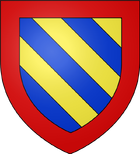
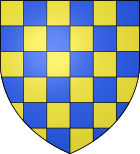
House of Vermandois
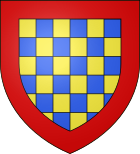
House of Dreux
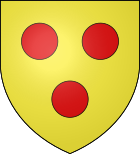
House of Courtenay
Arms of branches founded after Philip Augustus

House of Artois

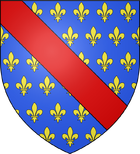
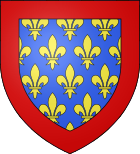
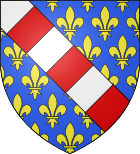
See also [ ]
- List of living legitimate male Capetians
- Genealogiae scriptoris Fusniacensis
- Capetian Armorial
- Treaty of Louviers
References [ ]
- ^ Specific periods of reign are 888–898, 922–923, 987–1792, 1814–1815, and 1815–1848 – the more-than-800-year uninterrupted period 987–1792 forming the bulk.
Further reading [ ]
- Ingmar Krause: Konflikt und Ritual im Herrschaftsbereich der frühen Capetinger – Untersuchungen zur Darstellung und Funktion symbolischen Verhaltens. Rhema-Verlag, Münster 2006, ISBN 978-3-930454-62-4
- Fawtier, Robert. The Capetian Kings of France: Monarchy & Nation (987–1328). Macmillan, 1960. (translated from French edition of 1941)
- Hallam, Elizabeth M. Capetian France 987–1328. Longman, 1980.
- Le Hête, Thierry. Les Capetiens: Le Livre du Millenaire. Editions Christian, 1987.
External links [ ]
- Marek, Miroslav. "Genealogies of the Capetian dynasty from Genealogy.eu". Genealogy.EU. http://genealogy.euweb.cz/capet/index.html.
| v• d •e Royal houses of Europe | |||||||||||||||||||||||||||||||||||||||||||||||||||||
|---|---|---|---|---|---|---|---|---|---|---|---|---|---|---|---|---|---|---|---|---|---|---|---|---|---|---|---|---|---|---|---|---|---|---|---|---|---|---|---|---|---|---|---|---|---|---|---|---|---|---|---|---|---|
| Albania | Angevin · Kastrioti · Wied · Zogu | ||||||||||||||||||||||||||||||||||||||||||||||||||||
| Austria | Babenberg · Habsburg · Habsburg-Lorraine | ||||||||||||||||||||||||||||||||||||||||||||||||||||
| Belgium | Saxe-Coburg and Gotha | ||||||||||||||||||||||||||||||||||||||||||||||||||||
| Bohemia | Přemyslid · Luxembourg · Jagiellon · Habsburg · Habsburg-Lorraine | ||||||||||||||||||||||||||||||||||||||||||||||||||||
| Bosnia | Kotromanić | ||||||||||||||||||||||||||||||||||||||||||||||||||||
| Bulgaria | Dulo · Cometopuli · Asen · Terter · Shishman · Battenberg · Saxe-Coburg and Gotha | ||||||||||||||||||||||||||||||||||||||||||||||||||||
| Croatia | Trpimirović · Domagojević · Svačić · Árpád · Angevin · Luxembourg · Habsburg · Habsburg-Lorraine · Savoy (disputed) | ||||||||||||||||||||||||||||||||||||||||||||||||||||
| Denmark | Early Danish Kings · House of Griffins · House of Pomerania · Palatinate-Neumarkt · Oldenburg · Schleswig-Holstein-Sonderburg-Glücksburg | ||||||||||||||||||||||||||||||||||||||||||||||||||||
| Finland | Bjelbo · Mecklenburg · Oldenburg · Vasa · Pfalz-Zweibrücken · Hesse · Holstein-Gottorp · Romanov | ||||||||||||||||||||||||||||||||||||||||||||||||||||
| France | Merovingian · Carolingian · Capet · Valois · Bourbon · Bonaparte · Orléans | ||||||||||||||||||||||||||||||||||||||||||||||||||||
| Georgia | Mukhrani · Bagrationi · Romanov | ||||||||||||||||||||||||||||||||||||||||||||||||||||
| Germany | Ascania · Carolingian · Conradines · Ottonian · Luitpolding · Salian · Hohenstaufen · Welf · Habsburg · Hanover · Saxe-Coburg and Gotha · Nassau · Luxembourg · Wittelsbach · Schwarzburg · Brunswick-Lüneburg · House of Griffins · House of Pomerania · Hohenzollern · Württemberg · Oldenburg · Schleswig-Holstein-Sonderburg-Glücksburg · Orange-Nassau · Nassau-Weilburg · Mecklenburg · Vasa · Pfalz-Zweibrücken · Hesse · Holstein-Gottorp · Romanov · Bonaparte · Wettin | ||||||||||||||||||||||||||||||||||||||||||||||||||||
| Greece | Wittelsbach · Schleswig-Holstein-Sonderburg-Glücksburg | ||||||||||||||||||||||||||||||||||||||||||||||||||||
| Hungary | Árpád · Přemyslid · Wittelsbach · Angevin · Luxembourg · Hunyadi · Jagiellon · Szapolyai · Habsburg · Habsburg-Lorraine | ||||||||||||||||||||||||||||||||||||||||||||||||||||
| Gaelic Ireland | Laigin · Síl Conairi · Ulaid · Dáirine · Osraige · Cruthin · Dál nAraidi · Connachta · Uí Fiachrach · Uí Briúin · Uí Néill · Síl nÁedo Sláine · Clann Cholmáin · Eóganachta · Chaisil · Glendamnach · Raithlind · Uí Dúnlainge · Uí Ímair (Norse) · Uí Cheinnselaig · Dál gCais · Ó Briain · Mac Carthaig · Ó Conchobhair · Ó Ruairc · Ó Domhnaill · Ó Néill | ||||||||||||||||||||||||||||||||||||||||||||||||||||
| Italy | Este · Savoy · Colonna · Medici · Borghese · Sforza · Borromeo · Montefeltro · Orsini · Visconti · Gonzaga · Farnese · Della Rovere · Acciaioli · Grimaldi · Pamphili · Barberini · Malatesta · Gens Iulia · Torlonia · Bonaparte · Bourbon-Parma · Bourbon-Two Sicilies | ||||||||||||||||||||||||||||||||||||||||||||||||||||
| Liechtenstein | Liechtenstein | ||||||||||||||||||||||||||||||||||||||||||||||||||||
| Lithuania | Mindaugas · Gediminids · Urach · Romanov | ||||||||||||||||||||||||||||||||||||||||||||||||||||
| Luxembourg | Orange-Nassau · Nassau-Weilburg · Bourbon-Parma | ||||||||||||||||||||||||||||||||||||||||||||||||||||
| |||||||||||||||||||||||||||||||||||||||||||||||||||||
Capetian Dynasty Definition Ap World History
Source: https://familypedia.fandom.com/wiki/Capetian_dynasty